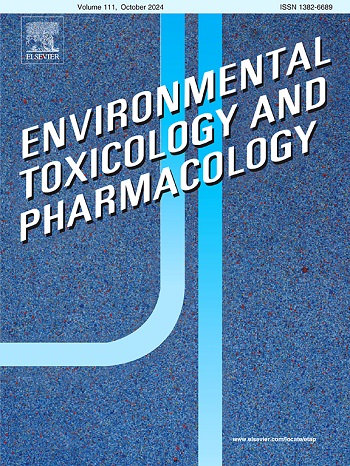从TLR4/NF-κB/NLRP3轴激活到小鼠帕金森病样非运动症状的毒性途径的构建
IF 4.2
3区 环境科学与生态学
Q2 ENVIRONMENTAL SCIENCES
引用次数: 0
摘要
联吡啶类除草剂,如百草枯,是世界上使用最广泛的除草剂之一。虽然肺是急性暴露于百草枯的主要靶器官,但长期暴露于百草枯被认为会诱发神经毒性,是神经退行性疾病的环境危险因素之一。在过去的二十年里,随着百草枯在一些地区被禁用,diquat逐渐成为百草枯的替代品。然而,对环境因素诱导的神经退行性疾病的系统研究尚不完整,有关威胁和风险评估的信息仍然不足。本研究的目的是调查联吡啶除草剂与散发性帕金森病之间的关系。其中,我们参考了Adverse Outcome Pathway (AOP)的概念,整合、分析并提出了类似AOP的毒性途径。它为我们进行传统的毒理学研究提供了思路。因此,本研究揭示联吡啶除草剂暴露通过激活TLR4/NF-κB/NLRP3轴导致蓝斑神经元热胞,从而导致小鼠帕金森病样非运动症状的发生。本文章由计算机程序翻译,如有差异,请以英文原文为准。
Construction of a toxicity pathway from activation of the TLR4/NF-κB/NLRP3 axis to Parkinson's disease-like non-motor symptoms in mice
Bipyridyl herbicides, like paraquat, are among the most widely used herbicides worldwide. Although the lungs are the main target organ for acute exposure to paraquat, chronic exposure to paraquat is thought to induce neurotoxicity and is one of the environmental risk factors for neurodegenerative diseases. In the last two decades, as paraquat has been banned in some regions, diquat has gradually become its replacement. However, systematic studies of environmental factor-induced neurodegenerative diseases are incomplete, and information on threats and risk assessment is still insufficient. The aim of this study was to investigate the association between bipyridine herbicides and sporadic Parkinson's disease. Among them, we refer to the concept of Adverse Outcome Pathway (AOP), integrate, analyse and propose the toxicity pathway similar to AOP. It provides ideas for us to conduct traditional toxicological studies. As a result, the present study reveals that bipyridine herbicide exposure causes neuronal pyrocytosis in locus coeruleus through activation of the TLR4/NF-κB/NLRP3 axis, resulting in the development of Parkinson's disease-like non-motor symptoms in mice.
求助全文
通过发布文献求助,成功后即可免费获取论文全文。
去求助
来源期刊
CiteScore
7.00
自引率
4.70%
发文量
185
审稿时长
34 days
期刊介绍:
Environmental Toxicology and Pharmacology publishes the results of studies concerning toxic and pharmacological effects of (human and veterinary) drugs and of environmental contaminants in animals and man.
Areas of special interest are: molecular mechanisms of toxicity, biotransformation and toxicokinetics (including toxicokinetic modelling), molecular, biochemical and physiological mechanisms explaining differences in sensitivity between species and individuals, the characterisation of pathophysiological models and mechanisms involved in the development of effects and the identification of biological markers that can be used to study exposure and effects in man and animals.
In addition to full length papers, short communications, full-length reviews and mini-reviews, Environmental Toxicology and Pharmacology will publish in depth assessments of special problem areas. The latter publications may exceed the length of a full length paper three to fourfold. A basic requirement is that the assessments are made under the auspices of international groups of leading experts in the fields concerned. The information examined may either consist of data that were already published, or of new data that were obtained within the framework of collaborative research programmes. Provision is also made for the acceptance of minireviews on (classes of) compounds, toxicities or mechanisms, debating recent advances in rapidly developing fields that fall within the scope of the journal.

 求助内容:
求助内容: 应助结果提醒方式:
应助结果提醒方式:


